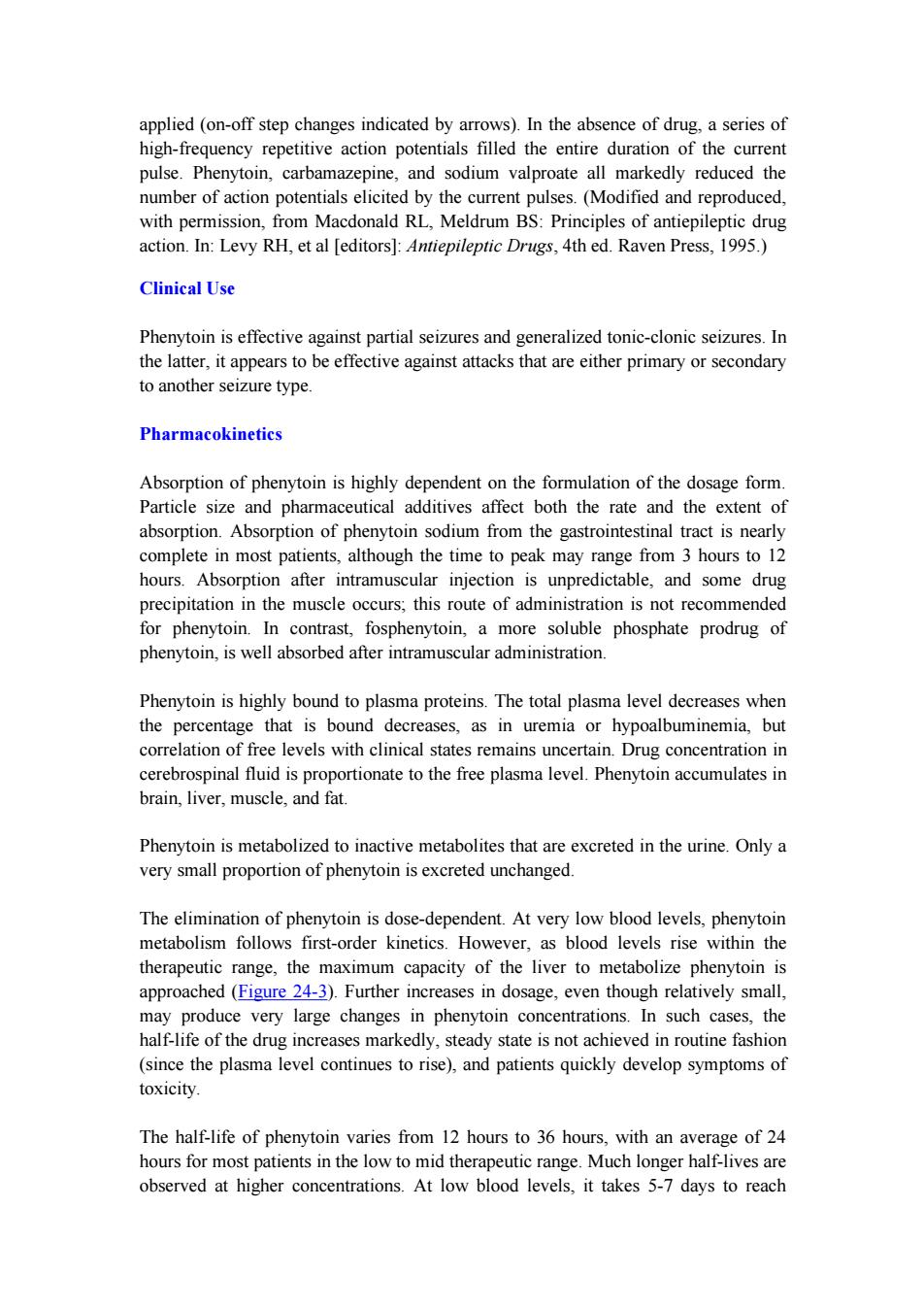正在加载图片...

applied (on-off step changes indicated by arrows).In the absence of drug,a series of high-frequency repetitive action potentials filled the entire duration of the current pulse.Phenytoin,carbamazepine,and sodium valproate all markedly reduced the number of action potentials elicited by the current pulses.(Modified and reproduced, with permission,from Macdonald RL,Meldrum BS:Principles of antiepileptic drug action.In:Levy RH,et al [editors]:Antiepileptic Drugs,4th ed.Raven Press,1995.) Clinical Use Phenytoin is effective against partial seizures and generalized tonic-clonic seizures.In the latter,it appears to be effective against attacks that are either primary or secondary to another seizure type. Pharmacokinetics Absorption of phenytoin is highly dependent on the formulation of the dosage form. Particle size and pharmaceutical additives affect both the rate and the extent of absorption.Absorption of phenytoin sodium from the gastrointestinal tract is nearly complete in most patients,although the time to peak may range from 3 hours to 12 hours.Absorption after intramuscular injection is unpredictable,and some drug precipitation in the muscle occurs;this route of administration is not recommended for phenytoin.In contrast,fosphenytoin,a more soluble phosphate prodrug of phenytoin,is well absorbed after intramuscular administration. Phenytoin is highly bound to plasma proteins.The total plasma level decreases when the percentage that is bound decreases,as in uremia or hypoalbuminemia,but correlation of free levels with clinical states remains uncertain.Drug concentration in cerebrospinal fluid is proportionate to the free plasma level.Phenytoin accumulates in brain,liver,muscle,and fat. Phenytoin is metabolized to inactive metabolites that are excreted in the urine.Only a very small proportion of phenytoin is excreted unchanged. The elimination of phenytoin is dose-dependent.At very low blood levels,phenytoin metabolism follows first-order kinetics.However,as blood levels rise within the therapeutic range,the maximum capacity of the liver to metabolize phenytoin is approached(Figure 24-3).Further increases in dosage,even though relatively small, may produce very large changes in phenytoin concentrations.In such cases,the half-life of the drug increases markedly,steady state is not achieved in routine fashion (since the plasma level continues to rise),and patients quickly develop symptoms of toxicity. The half-life of phenytoin varies from 12 hours to 36 hours,with an average of 24 hours for most patients in the low to mid therapeutic range.Much longer half-lives are observed at higher concentrations.At low blood levels,it takes 5-7 days to reachapplied (on-off step changes indicated by arrows). In the absence of drug, a series of high-frequency repetitive action potentials filled the entire duration of the current pulse. Phenytoin, carbamazepine, and sodium valproate all markedly reduced the number of action potentials elicited by the current pulses. (Modified and reproduced, with permission, from Macdonald RL, Meldrum BS: Principles of antiepileptic drug action. In: Levy RH, et al [editors]: Antiepileptic Drugs, 4th ed. Raven Press, 1995.) Clinical Use Phenytoin is effective against partial seizures and generalized tonic-clonic seizures. In the latter, it appears to be effective against attacks that are either primary or secondary to another seizure type. Pharmacokinetics Absorption of phenytoin is highly dependent on the formulation of the dosage form. Particle size and pharmaceutical additives affect both the rate and the extent of absorption. Absorption of phenytoin sodium from the gastrointestinal tract is nearly complete in most patients, although the time to peak may range from 3 hours to 12 hours. Absorption after intramuscular injection is unpredictable, and some drug precipitation in the muscle occurs; this route of administration is not recommended for phenytoin. In contrast, fosphenytoin, a more soluble phosphate prodrug of phenytoin, is well absorbed after intramuscular administration. Phenytoin is highly bound to plasma proteins. The total plasma level decreases when the percentage that is bound decreases, as in uremia or hypoalbuminemia, but correlation of free levels with clinical states remains uncertain. Drug concentration in cerebrospinal fluid is proportionate to the free plasma level. Phenytoin accumulates in brain, liver, muscle, and fat. Phenytoin is metabolized to inactive metabolites that are excreted in the urine. Only a very small proportion of phenytoin is excreted unchanged. The elimination of phenytoin is dose-dependent. At very low blood levels, phenytoin metabolism follows first-order kinetics. However, as blood levels rise within the therapeutic range, the maximum capacity of the liver to metabolize phenytoin is approached (Figure 24-3). Further increases in dosage, even though relatively small, may produce very large changes in phenytoin concentrations. In such cases, the half-life of the drug increases markedly, steady state is not achieved in routine fashion (since the plasma level continues to rise), and patients quickly develop symptoms of toxicity. The half-life of phenytoin varies from 12 hours to 36 hours, with an average of 24 hours for most patients in the low to mid therapeutic range. Much longer half-lives are observed at higher concentrations. At low blood levels, it takes 5-7 days to reach